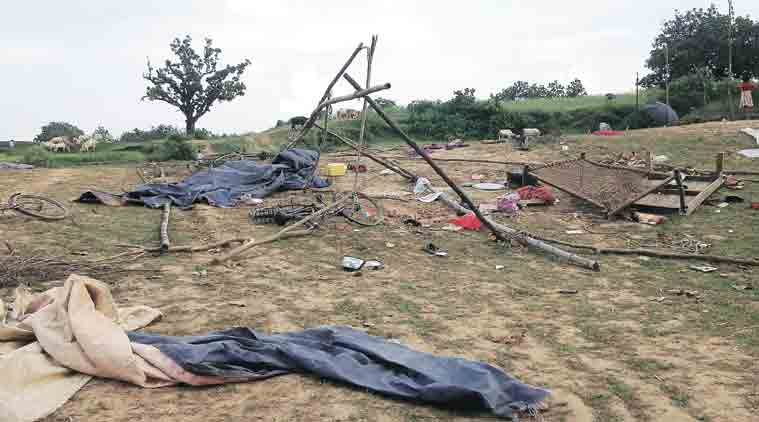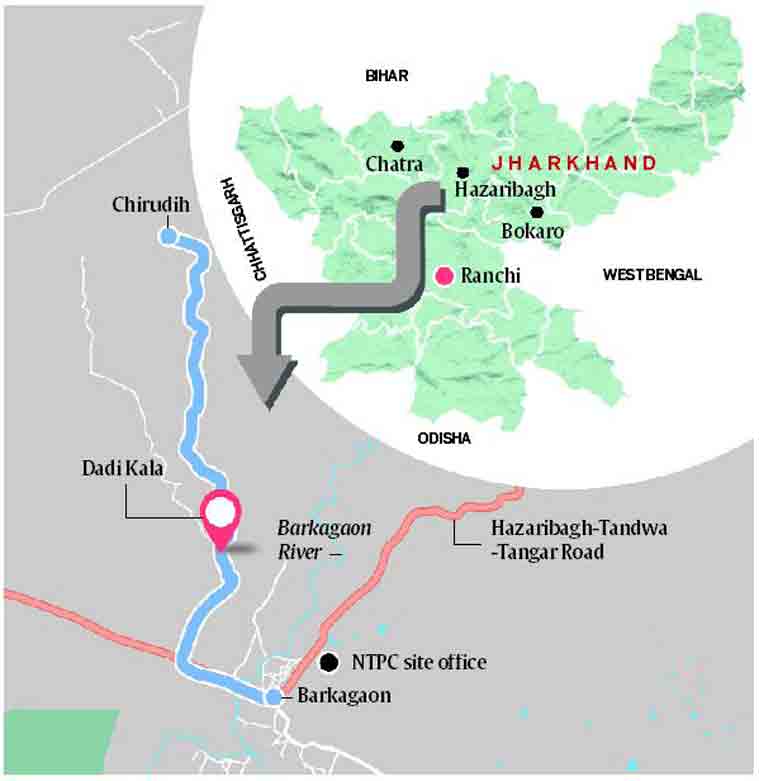- India
- International
Land acquisition and protests, power and politics in Jharkhand’s coal belt
Indian Express explains the background and circumstances of a dozen years of protest against a coal mining project, the snatching of an MLA from custody by a mob, and the subsequent deaths of 4 people in firing by the police.
 The wrecked site where Congress MLA Nirmala Devi was leading a protest before she was arrested on October 1. (Express Photo: Prashant Pandey)
The wrecked site where Congress MLA Nirmala Devi was leading a protest before she was arrested on October 1. (Express Photo: Prashant Pandey)
On October 1, at a village called Dadi Kala on the road from Barkagaon town in Jharkhand’s Hazaribagh district to Chirudih in the same district, a 1,000-strong mob attacked a police team that had arrested a Congress MLA who had been leading a protest at a local coal mining project site for the past 15 days. The mob assaulted senior officers and freed the MLA, Nirmala Devi, who represents Barkagaon constituency in the Assembly. Police opened fire, in which 4 individuals, including 3 minors, were killed.
Over the next couple of days, Chief Minister Raghubar Das’s government came under attack from the opposition, and the CPM described the police action as a “surgical strike against farmers”, borrowing from the terminology of the Army’s raids on terror camps across the LoC last month. On Tuesday, police arrested Yogendra Saw, the husband of Nirmala Devi and a minister in the 2013-14 Hemant Soren government, for instigating the violence at Dadi Kala. Nirmala Devi has not been seen in public since October 1.
Watch What Else Is Making News
The chain of events has brought focus back on a languishing coal mining project of the NTPC spread over more than 25 big and small villages in the Pakri-Barwadih area of Barkagaon block, and associated issues of acquisition of land, compensation, relief and rehabilitation. Why and how did the situation reach the flashpoint of October 1?

What is the project about?
In November 2004, a few months after UPA-I came to power, NTPC was allocated captive coal blocks in Pakri-Barwadih, Chatti Bariatu and Keredari areas of Hazaribagh to cater to the Maharatna giant’s proposed new North Karanpura Super Thermal Power Project in the neighbouring Chatra district. Clearances for the project were obtained by 2010, but in 2014, the Supreme Court quashed allocations of more than 200 coal blocks over allegations of corruption, including those of these blocks. The blocks were, however, re-allocated to NTPC in 2015.
What is the status of land acquisition?
NTPC has notified 8,000 acres for acquisition in Pakri-Barwadih, affecting more than 25 villages, although some activists say 40 villages will be hit. NTPC officials say nearly 4,000 acres — essentially forest land — is already with them, and necessary clearances have been obtained. Of the 700-odd acres of private, or raiyyat, land notified for the project, some 400 acres have been acquired; the process of NTPC purchasing the remaining land is currently under way. Most of the acquisition has been carried out under the Coal Bearing Areas (Acquisition & Development) Act, 1957. NTPC officials say the Land Acquisition Act, 1894, would apply to about 700 acres on which there is some human habitation or farming — this land is required to build supporting infrastructure for mining. Under Section 9 of the Coal Bearing Areas Act, a notified piece of land can no longer be sold by the possessor.
Has work started on the project?

Yes. NTPC engaged a contractor in 2015, and work began 4-5 months ago. It’s now in the stage of “over-burden removal”, i.e. removal of layers of earth, so that the actual mining can begin.
Who is protesting? When did the protests start?
Protests against the project started almost immediately after the coal block was allocated and company officials began visiting the site. But the first organised forum, Karanpura Bachao Sangharsh Samiti, was set up in 2015, and a couple of others like Janmabhoomi Raksha Samiti and Buddhijeevi Manch entered the picture subsequently. The protests, despite their fairly clear agenda and programme, were initially led largely by local activists with no visible political affiliations or even a defined leadership. The agitation remained confined to sit-ins and demonstrations at first, but later evolved into a showcase for innovation such as the so-called ‘Koyla Satyagrah’, during which around 500 villagers started “mining” on their own and offered “royalty” to the government to press their demand that they be given the project’s ownership rights.
Okay, but what exactly do the protesters want?
Broadly, they want adequate compensation for the land they have given for the project, a job in the project, and proper rehabilitation. But some villagers do not want to give up their lands, saying it is fertile enough to produce three crops a year. Farmers say they are able to produce enough rice, wheat and vegetables to sustain themselves, as well as to sell in times of need. They also allege that no aspect of the project has been discussed with the gram sabhas.
So, has anybody actually got compensation for their land?
According to NTPC officials, people come almost every day to claim compensation which has been revised from the initial Rs 3 lakh per acre to Rs 20 lakh per acre now. People in the affected area estimate that some 20 people on average in each village have accepted compensation. However, these people also insist that the compensation alone is not enough to make up for the loss of their lands.
And has NTPC done anything apart from handing out money?
It has carried out public works like strengthening school buildings, constructing plain cement concrete (PCC) roads, making provisions for water supply in summer, and setting up medical camps. NTPC is also building a rehabilitation colony in Dhenga village a kilometre away from Barkagaon. Work on this project was, however, stopped some 45 days ago after villagers complained about the poor quality of the houses. A quality audit by a third party is awaited.
How did Yogendra Saw and Nirmala Devi enter the picture?
According to activists and local people, the Congress leader sought to exploit the protest against NTPC for his own political ends. Saw became MLA in 2009 and subsequently a Minister, but had to resign in September 2014 after alleged Maoist-linked extortionists of a gang called the Jharkhand Tiger Force named him as their leader. He was in jail during the Assembly polls of November-December, but managed to push his wife into politics, who won the Bakargaon seat by a slim margin of 411 votes on a Congress ticket. Nirmala Devi has been leading protests at the site ever since — and while the October 1 incident has been the bloodiest so far, there has been violence earlier too. In August 2015, 3 farmers were injured in police firing and two vehicles were burnt after Nirmala led a protest against the rehabilitation colony in Dhenga and, earlier this year, police used force to disperse protesters at least twice — in May and July. Nirmala was part of both protests.
So where do things stand now, and where are they headed?
Chief Minister Raghubar Das had met farmers around 45 days ago for “direct talks” in Ranchi, where he assured them that their demands would be looked into. Hazaribagh MP and Union Minister of State for Civil Aviation, Jayant Sinha, and his father and senior BJP leader Yashwant Sinha, have promised the farmers a more comprehensive compensation package. But there is palpable anger on the ground after the October 1 killings and the subsequent raids by police in the hunt for suspects. Nothing has come out of the promises by Das, Jayant Sinha and Yashwant Sinha, villagers allege. NTPC officials accuse Saw and Nirmala of instigating people. They also say that given that the project started in 2004, not much can be done based on The Right to Fair Compensation and Transparency in Land Acquisition, Rehabilitation and Resettlement Act passed under UPA 2 in 2013. The opposition in the state is likely to work towards keeping the anger against the BJP governments in Ranchi and New Delhi alive, and the stalemate looks set to continue, at least for now.
More Explained
Must Read
EXPRESS OPINION
Apr 23: Latest News
- 0113 hours ago
- 0213 hours ago
- 0324 hours ago
- 0413 hours ago
- 0523 hours ago








































